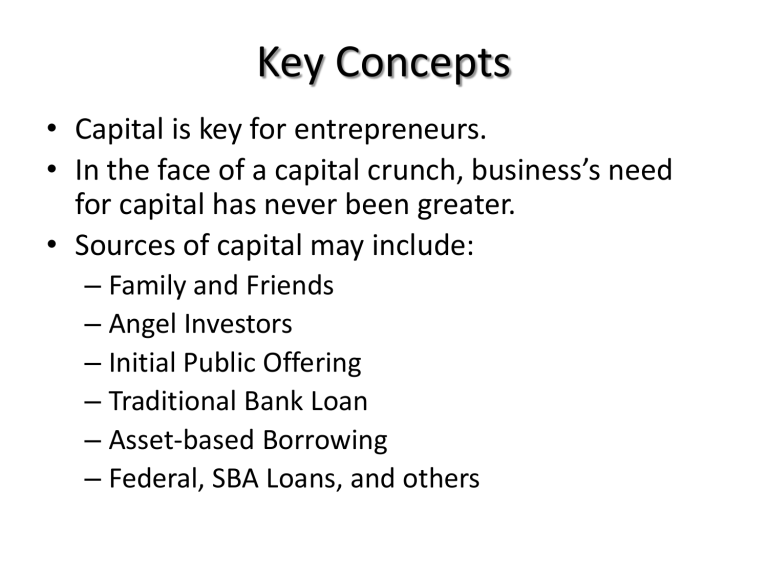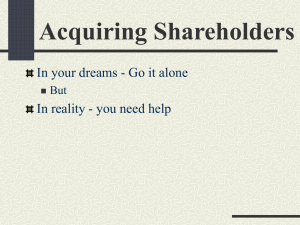Chapter #13 – Funding and Financing

Key Concepts
• Capital is key for entrepreneurs.
• In the face of a capital crunch, business’s need for capital has never been greater.
• Sources of capital may include:
– Family and Friends
– Angel Investors
– Initial Public Offering
– Traditional Bank Loan
– Asset-based Borrowing
– Federal, SBA Loans, and others
Raising Capital
• Raising capital to launch or expand a business is a challenge.
• Many entrepreneurs are caught in a
“credit crunch.”
• Financing needs in the $100,000 to $3 million range may be the most challenging to fill.
The “Secrets” to
Successful Financing
1. Choosing the right sources of capital can be as important as choosing the right form of ownership or the right location.
2. The money is out there; the key is knowing where to look.
3. Raising money takes time and effort.
4. Creativity counts. Entrepreneurs have to be as creative in their searches for capital as they are in developing their business ideas.
The “Secrets” to
Successful Financing
(continued)
5. The Internet puts at entrepreneur’s fingertips vast resources of information that can lead to financing.
6. Put social media to work to locate potential investors.
7. Be thoroughly prepared before approaching lenders and investors.
8. Entrepreneurs cannot overestimate the importance of making sure that the “chemistry” among themselves, their companies, and their funding sources is a good one.
9. Plan an exit strategy
Exit Strategy
Sell the Business
• Google is not going to buy your business
IPO
• Least Likely… very difficult and expensive
Cash Flow
• This is the Key
• Without Cash Flow none of the others are viable
Financing a Business
• Entrepreneurs must cast a wide net to capture the financing they need to launch their businesses.
• Layered financing – piecing together capital from multiple sources.
• “Tranches”
Three Types of Capital
In addition to the text
Capital is any form of wealth employed to produce more wealth for a firm.
1.
2.
3.
Fixed - Used to purchase the permanent or fixed assets of the business (e.g., buildings, land, equipment, and others). Banks
Working - Used to support the small company's normal short-term operations (e.g., buy inventory, pay bills, wages, or salaries, and others). Banks
Growth - Used to help the small business expand or change its primary direction. Investors
Equity Capital
• Represents the personal investment of the owner(s) in the business.
• Is called risk capital because investors assume the risk of losing their money if the business fails.
• Does not have to be repaid with interest like a loan does.
• Means that an entrepreneur must give up some ownership in the company to outside investors.
Debt Capital
• Must be repaid with interest.
• Is carried as a liability on the company’s balance sheet.
• Can be just as difficult to secure as equity financing, even though sources of debt financing are more numerous.
• Can be expensive, especially for small companies, because of the risk/return tradeoff.
Hybrid of Debt Equity Capital
Convertible Debt
• Very attractive to investors.
• Guaranteed Return with…
• Equity Potential
Preferred Stock
• Pays a Dividend that is Guaranteed
• Non-Voting
Sources of Equity Financing
(continued)
• Personal savings
• Friends and family members
• Crowd funding
• Angels
• Partners
• Venture capital companies
• Corporate venture capital
• Public stock sale – “going public”
• Simplified registrations and exemptions
Personal Savings
• The first place an entrepreneur should look for money.
• The most common source of equity capital for starting a business.
• Outside investors and lenders expect entrepreneurs to put some of their own capital into the business before investing theirs.
Friends and Family Members
• After emptying their own pockets, entrepreneurs should turn to those most likely to invest in the business: friends and family members.
• Be careful! Inherent dangers lurk in family/friendly business deals, especially those that flop.
Friends and Family Members
Guidelines for family and friendship financing:
– Choose your financier carefully.
– Keep the arrangement “strictly business.”
– Prepare a business plan.
– Settle the details up front.
– Create a written contract.
– Treat the money as “bridge financing.”
– Develop a payment schedule that suits both parties.
– Have an exit plan.
Crowd Funding
• Crowd funding taps the power of social networking and allows entrepreneurs to post their elevator pitches and proposed investment terms on specialized Web sites and raise money from ordinary people who invest as little as $100.
– The amount of capital sought tends to be small – less than $10,000.
– The returns for investment are tokens – discount coupons and free samples.
Angels
• Wealthy individuals who invest in emerging entrepreneurial companies in exchange for equity
(ownership) stakes.
• An excellent source of “patient money” for investors needing relatively small amounts of capital typically ranging from $100,000 (sometimes less) to as much as $5 million.
• Willing to invest in the early stages of a business.
Angels
• An estimated 318,000 angels across the U.S. invest $22.5 billion a year in 66,000 small companies.
• Their investments exceed those of venture capital firms, providing more capital to 18 times as many small companies.
• Angels fill a gap in the seed capital market, specifically in the $10,000 to $2 million range.
Angels
Average angel investment = $50,000 in a company that is in the seed or start-up growth stage.
Typical angel invests in 1 company per year, and the average time to close a deal is 67 days.
52% of angels’ investments lose money, but 7% produce a return more than 10 times their original investment.
Angels can be an excellent source of “patient” money.
Angels
The Challenge: Finding Them!
– Network
– Look nearby: within a 50- to 100-mile radius
• 7 out of 10 angels invest in companies that are within
50 miles of their homes or offices.
– Informal angel “clusters” and networks
• 340 angel groups across the U.S.
• Internet
Angel Financing
Partners
• Giving up personal control
• Diluting ownership
• Sharing profits
• “For every penny you get in the door, you have to give something up.”
Venture Capital Companies
• More than 400 venture capital firms operate across the U.S.
• Most venture capitalists seek investments in the $5 million to $25 million range
• Target companies with high-growth and highprofit potential.
• Business plans are subjected to an extremely rigorous review - less than 1% accepted.
The Business Plan Funnel
Venture Capital Funding
Venture Capital Companies
(continued)
• Most often, venture capitalists invest in a company across several stages.
• On average, 96-98% of venture capital goes to:
– Early stage investments (companies in the early stages of development).
– Expansion stage investments (companies in the rapid growth phase).
• Only about 2% of venture capital goes to businesses in the startup or seed phase.
Venture Capital Companies
(continued)
Venture Capital Companies
(continued)
Venture Capital Companies
(continued)
Venture Capital Companies
(continued)
Angel Investing and
Venture Capital Investing
What Do Venture Capital
Companies Look For?
• Competent management
• Competitive edge
• Growth industry
• Viable exit strategy
• Intangibles factors
Corporate Venture Capital
• About 300 large corporations across the globe invest in start-up companies.
• Approximately 14% of all venture capital invested is from corporations.
• Capital infusions are just one benefit; corporate partners may share marketing and technical expertise.
Going Public
• Initial public offering (IPO) - when a company raises capital by selling shares of its stock to the public for the first time.
• Since 2001, the average number of companies making IPOs each year is 134.
• Few companies with less than $25 million in annual sales make IPOs.
Initial Public Offerings (IPOs)
Successful IPO Candidates Have…
• Consistently high growth rates
• Scalability
• Strong record of earnings
• 3 to 5 years of audited financial statements that meet or exceed SEC standards
• Solid position in a rapidly-growing industry: Average company age is 10 years
• Sound management team with experience and a strong board of directors
Advantages of
“Going Public”
In addition to the text
• Ability to raise large amounts of capital
• Improved corporate image
• Improved access to future financing
• Attracting and retaining key employees
• Using stock for acquisitions
• Listing on a stock exchange
Disadvantages of
“Going Public”
In addition to the text
• Dilution of founder’s ownership
• Loss of control
• Loss of privacy
• Reporting to the SEC
• Filing expenses
• Accountability to shareholders
• Pressure for short-term performance
• Timing
Timetable for an IPO
The Registration Process
• Choose the underwriter
• Negotiate a letter of intent
• Prepare the registration statement
• File with the SEC
• Wait to “go effective” and road show
• Meet all state requirements
Simplified Registrations and Exemptions
Goal:
To give small companies easy access to capital markets with simplified registration requirements
Simplified Registrations and Exemptions
• Regulation S-B and S-K
• Regulation D (Rule 504): Small Company
Offering Registration (SCOR)
• Regulation D (Rule 505 and 506): Private
Placements
• Section 4 (6) Private Placements
• Intrastate Offerings (Rule 147)
• Regulation A
Simplified Registrations and Exemptions
Accredited Investor
A - $1 million in net worth excluding primary residence,
Or
B - $200K in Income for 2 years in a row (single)
Or
C- $300K in Income for 2 years in a row (married)
Simplified Registrations and Exemptions
RULE 504
1. Up to $1 million per year
2. Unlimited # of Accredited Investors
3. Comply with State Exemptions
4. Non Restricted Securities
Simplified Registrations and Exemptions
RULE 505
1. Up to $5 million per year
2. Unlimited # of Accredited Investors
3. Up to 35 Non-Accredited Investors
4. Certified Financial Statements – Audit
5. Restricted Securities – No Trading Allowed
Simplified Registrations and Exemptions
RULE 506 a or b
1. No Limit on Capital Raised
2. Unlimited # of Accredited Investors
3. Up to 35 Non-Accredited Investors
4. Certified Financial Statements - Audit
5. Restricted Securities – No Trading Allowed
Simplified Registrations and Exemptions
RULE 506 c – Crowd Funding
1. No Limit on Capital Raised
2. Unlimited # of Accredited Investors
3. No Non-Accredited Investors
4. Certified Financial Statements - Audit
5. Restricted Securities – No Trading Allowed
6. Must Verify Accredited Investor Status
The Nature of Debt Financing
• Debt financing is a popular tool used by entrepreneurs to acquire capital.
• Borrowed capital allows entrepreneurs to maintain complete ownership of their businesses, but must be repaid with interest.
• Small businesses are considered more risky than corporate customers.
– Prime rate
Debt Financing
Fifty percentage of all business loan applications are not approved for the following reasons
1. Weak personal credit- scores at least 650 and above
2. Inexperienced management- at least 2 years
3. Insufficient collateral to secure the loan
4. Weak Key Financial Indicators: Cash Flow debt coverage, Liquidity, Leverage
Debt Financing
Collateral
The borrowing bases for each type of collateral are as follows:
1. Accounts receivable- 75%
2. Inventory- 50%
3. Equipment- 75%
4. Real Estate- 75% to 90%
Debt Financing
Personal Information
• Personal Financial Statement
• Each owner over 19%
• All guarantors
1. Personal tax returns: 3 years
2. Personal Credit Reports: Current
• Resume of principals
Debt Financing
Corporate Information
• FYE Financial Statements - 3 years
• Tax returns for most recent - 3 years
• Current Financial Statement of Business (less than 60 days old).
• Aging of:
1.
Accounts Receivable- match current date of financial statement
2.
Accounts Payable- match current date of financial statement
• Debt Schedule- Existing Debt
1.
Match current date of financial statement
• History of Business
• Copy of the property lease
• Corporate Papers
Small Business Financing Strategies
Sources of Debt Capital
• Commercial banks
– Lenders of first resort for small businesses
– Average micro-business loan = $7,400
– Average small business loan = $181,000
– Study: 12% of entrepreneurs receive bank loans to start their businesses.
Sources of Debt Capital From
Commercial Banks
• Short-term loans
–
–
Home Equity Loans
Commercial Loans
– Lines of Credit
– Floor planning
• Immediate and Long-Term Loans
– Installment Loans
– Term Loans
Six Common Reasons Bankers Reject Small
Business Loans
In addition to the text
1. “Our bank doesn’t make small business loans.”
Cure: Before applying for a loan, research banks to find out which ones seek the type of loan you need.
2. “I don’t know enough about you or your business.”
Cure: Develop a detailed business plan to present to the banker.
Six Common Reasons Bankers Reject
Small Business Loans
(continued) In addition to the text
3. “You haven’t told me why you need the money.”
Cure: Your business plan should explain how much money you need and how you plan to use it.
4.
“Your numbers don’t support your loan request.”
Cure: Include a cash flow forecast in your business plan.
Six Common Reasons Bankers Reject Small
Business Loans
(continued) In addition to the text
5. “You don’t have enough collateral.”
Cure: Be prepared to pledge your company’s assets – and perhaps your personal assets – as collateral for the loan.
6.
“Your business does not support the loan on its own.”
Cure: Be prepared to provide a personal guarantee on the loan.
Asset-Based Lenders
• Businesses can borrow money by pledging as collateral otherwise idle assets – accounts receivable, inventory, and others.
• Advance rate – the percentage of an asset’s value that a lender will lend.
Asset-Based Borrowing
• Discounting accounts receivable
• Inventory financing
• Purchase order financing
1. Accounts receivable- 75%
2. Inventory- 50%
3. Equipment- 75%
4. Real Estate- 75% to 90%
Other Sources of Debt Capital
Vendor financing (trade credit)
Equipment suppliers
Commercial finance companies
Saving and loan associations
Stock brokers
Other Sources of Debt Capital
(continued)
Credit unions
Private placements
Small Business Investment
Companies (SBIC)
Small Business Lending Companies
(SBLCs)
Federally Sponsored Programs
• Economic Development Administration (EDA)
• Department of Housing and Urban Development
(HUD)
• U.S. Department of Agriculture’s Rural Business
(USDA) - Cooperative Service
• Small Business Innovation Research (SBIR)
• Small Business Technology Transfer programs (STTR)
• Small Business Administration (SBA)
SBA 7(A) Guaranteed Loans
Other Methods of Financing
• Factoring Accounts Receivable – selling accounts receivable outright
• Leasing – assets rather than buying them
• Credit cards




